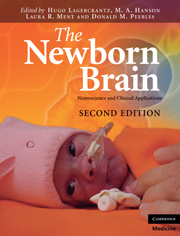Book contents
- Frontmatter
- Contents
- List of contributors
- Preface to the First Edition
- Preface to the Second Edition
- 1 Reflections on the origins of the human brain
- Section 1 Making of the brain
- Section 2 Sensory systems and behavior
- 9 Development of the somatosensory system
- 10 Principles of endogenous and sensory activity-dependent brain development: the visual system
- 11 Fetal and neonatal development of the auditory system
- 12 Newborn behavior and perception
- Section 3 Radiological and neurophysiological investigations
- Section 4 Clinical aspects
- Section 5 Follow-up
- Section 6 Consciousness
- Index
- Plate section
- References
11 - Fetal and neonatal development of the auditory system
from Section 2 - Sensory systems and behavior
Published online by Cambridge University Press: 01 March 2011
- Frontmatter
- Contents
- List of contributors
- Preface to the First Edition
- Preface to the Second Edition
- 1 Reflections on the origins of the human brain
- Section 1 Making of the brain
- Section 2 Sensory systems and behavior
- 9 Development of the somatosensory system
- 10 Principles of endogenous and sensory activity-dependent brain development: the visual system
- 11 Fetal and neonatal development of the auditory system
- 12 Newborn behavior and perception
- Section 3 Radiological and neurophysiological investigations
- Section 4 Clinical aspects
- Section 5 Follow-up
- Section 6 Consciousness
- Index
- Plate section
- References
Summary
Introduction: traditional and modern biological approaches to the development of the ear
The ear is a doorway to the brain – an extension of the brain that reaches out to the periphery to collect and form structural images of sounds in the milieu. The ear informs the brain and hence the organism of the imperative sounds of development, communication, and survival. The complex hearing apparatus that forms the “ear” provides the foundation for auditory interactions with the environment and serves as the essential component of two-way communication between organisms. In mammals, the mechanical vibrations of air particles that form the physical dimension of sound are collected by the external ear, and amplified and channeled through a narrow canal within the skull to reach the sensitive eardrum or tympanic membrane. The external auditory canal and the tympanic membrane form the first section of the superbly designed mammalian ear, which is an intricate sensory system composed of a series of complicated subsystems, linked in series, to perform vibro-mechanical conduction, hydrostatic pressure matching, and mechanoelectrical transduction (Fig. 11.1). Each of these unique subsystems must be intact for sound to optimally reach the eighth cranial nerve, higher auditory tracts, nuclei and auditory cortex of the brain to initiate sound perception. Auditory stimuli that are processed by the contiguous external, middle, and internal (cochlear) components of the ear system are conveyed as neuro-electrical signals to the brain by the eighth cranial nerve.
- Type
- Chapter
- Information
- The Newborn BrainNeuroscience and Clinical Applications, pp. 163 - 184Publisher: Cambridge University PressPrint publication year: 2010
References
- 3
- Cited by

